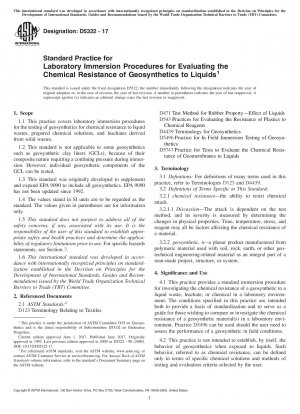ASTM D5322-17
Standard Practice for Laboratory Immersion Procedures for Evaluating the Chemical Resistance of Geosynthetics to Liquids
- Standard No.
- ASTM D5322-17
- Release Date
- 2017
- Published By
- American Society for Testing and Materials (ASTM)
- Status
- Replace By
- ASTM D5322-23
- Latest
- ASTM D5322-23
- Scope
-
4.1 This practice provides a standard immersion procedure for investigating the chemical resistance of a geosynthetic to a liquid waste, leachate, or chemical in a laboratory environment. The conditions specified in this practice are intended both to provide a basis of standardization and to serve as a guide for those wishing to compare or investigate the chemical resistance of a geosynthetic material(s) in a laboratory environment. Practice D5496 can be used should the user need to assess the performance of a geosynthetic in field conditions.
4.2 This practice is not intended to establish, by itself, the behavior of geosynthetics when exposed to liquids. Such behavior, referred to as chemical resistance, can be defined only in terms of specific chemical solutions and methods of testing and evaluation criteria selected by the user.
1.1 This practice covers laboratory immersion procedures for the testing of geosynthetics for chemical resistance to liquid wastes, prepared chemical solutions, and leachates derived from solid wastes.
1.2 This standard is not applicable to some geosynthetics such as geosynthetic clay liners (GCLs), because of their composite nature requiring a confining pressure during immersion. However, individual geosynthetic components of the GCL can be tested.
1.3 This standard was originally developed to supplement and expand EPA 9090 to include all geosynthetics. EPA 9090 has not been updated since 1992.
1.4 The values stated in SI units are to be regarded as the standard. The values given in parentheses are for information only.
1.5 This standard does not purport to address all of the safety concerns, if any, associated with its use. It is the responsibility of the user of this standard to establish appropriate safety and health practices and determine the applicability of regulatory limitations prior to use. For specific hazards statements, see Section 7.
1.6 This international standard was developed in accordance with internationally recognized principles on standardization established in the Decision on Principles for the Development of International Standards, Guides and Recommendations issued by the World Trade Organization Technical Barriers to Trade (TBT) Committee.
ASTM D5322-17 Referenced Document
- ASTM D123 Standard Terminology Relating to Textiles
- ASTM D4439 Standard Terminology for Geosynthetics
- ASTM D471 Standard Test Method for Rubber Property-Effect of Liquids
- ASTM D543 Standard Practices for Evaluating the Resistance of Plastics to Chemical Reagents
- ASTM D5496 Standard Practice for In Field Immersion Testing of Geosynthetics
- ASTM D5747 Standard Practice for Tests to Evaluate the Chemical Resistance of Geomembranes to Liquids
ASTM D5322-17 history
- 2023 ASTM D5322-23 Standard Practice for Laboratory Immersion Procedures for Evaluating the Chemical Resistance of Geosynthetics to Liquids
- 2017 ASTM D5322-17 Standard Practice for Laboratory Immersion Procedures for Evaluating the Chemical Resistance of Geosynthetics to Liquids
- 1998 ASTM D5322-98(2009) Standard Practice for Immersion Procedures for Evaluating the Chemical Resistance of Geosynthetics to Liquids
- 1998 ASTM D5322-98(2003) Standard Practice for Immersion Procedures for Evaluating the Chemical Resistance of Geosynthetics to Liquids
- 1998 ASTM D5322-98 Standard Practice for Immersion Procedures for Evaluating the Chemical Resistance of Geosynthetics to Liquids
